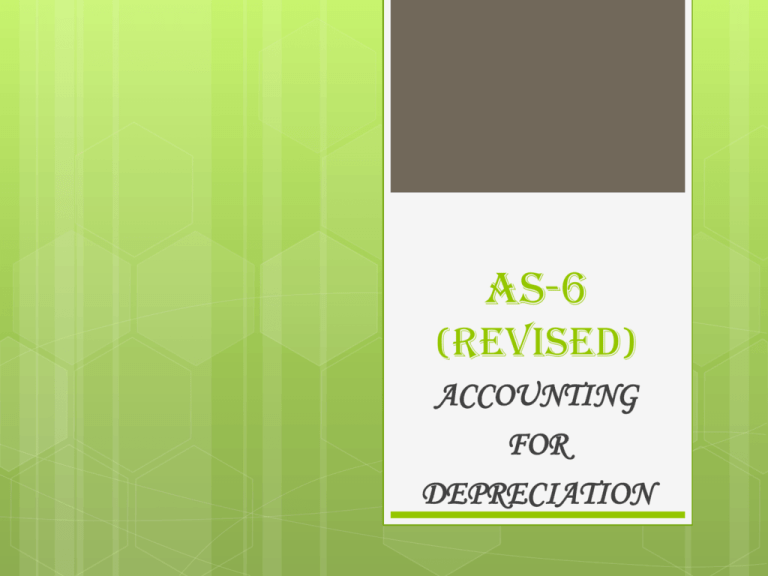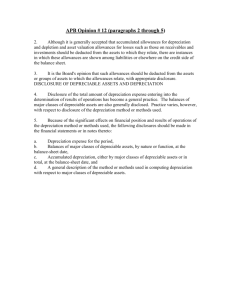AS-6 (REVISED)
advertisement

AS-6 (REVISED) ACCOUNTING FOR DEPRECIATION DEPRECIATION ACCOUNTING “Depreciation Accounting” was issued by the Institute in 1985 , in the context of insertion of schedule xiv in the companies act in 1988 , the institute brought out a Guidance note on Accounting for Depreciation in Companies. The guidance note differed from AS-6 in respect of accounting treatment of (a)change in the method of depreciation & (b)change in the rates of depreciation Based on the recommendation of the Accounting standards Board & also in the context of delinking the rate of depreciation under the Companies (Amendment) Act 1988 , the council of the institute at its meeting held on may 26-29,1994 decided to bring AS-6 with the guidance note in respect of afore mentioned matter. INTRODUCTION “Depreciation is loss of value of an asset” Depreciation means : A measure of wearing out Consumption other loss of value of a asset arising from use Passage of time , obsolesences through technology and market changes Amortization of an asset Depreciation is nothing but allocation of total cost of assets over its useful life. APPLICABILITY This Accounting standard is applicable to all depreciable assets Except the following • Forests & plantations • Wasting assets , minerals and natural gas • Expenditure on research and development • Goodwill • Live stock- cattle animal husbandry WHAT DO YOU MEAN BY DEPRECIABLE ASSET : They are expected to be used for more than one accounting year Have a limited useful life Are held use in production of goods & services CALCULATION OF DEPRECIATION The amount of depreciation is calculated as under: Historical cost or other amount in place of historical cost like revalued amount Estimated useful life of depreciable assets Estimated residual / scrap value of depreciable asset. cost - (scrap value at the end of useful life) Depreciation amount = estimated useful life in no. of years COST OF DPRECIABLE ASSET : it means Is total cost spent in connection with its acquisition Installation and commissioning for add item Or improvement of the depreciable asset Contd… THE HISTORICAL COST MAY CHANGE DUE TO FOLLOWING FACTORS Increase / decrease in long term liability on account of exchange fluctuation Price-adjustment Changes in duties Revaluation of depreciable assets Other similar reason ESTIMATED USEFUL LIFE OF DEPRECIABLE ASSET : “USEFUL LIFE “ is either The period over which a depreciable asset is expected to be used by the enterprise (OR) The number of production or similar units expected to be obtained from the use of the asset by the enterprise THE USEFUL LIFE DEPENDS UPON THE FOLLOWING FACTORS: Predetermined by legal or contractual limits (lease) Depend the number of shifts for which the assets is to be used Repairs and maintenance policy of enterprise Technological obselesences Innovations / improvements in the production method Change in demand of output Legal or other restriction SCRAP VALUE AND DEPRECIABLE AMOUNT ESTIMATED RESIDUAL / SCRAP VALUE OF DEPRECIABLE ASSET: It is estimated value of depreciable asset at end of its useful life It Is generally difficult to determine the residual value But it is estimated at the time of acquisition , installation and At the time of revaluation of the asset MEANING OF DEPRECIABLE AMOUNT : a) Historical cost – estimated scrap value b) Depreciable amount is allocated over the estimated useful life of depreciable asset METHODS OF DEPRECIATION There are two methods of depreciation which are most commonly employed in industrial and commercial enterprises. they are as follows: A. B. Straight line method (SLM) Written down value method (WDV) The management uses most appropriate method(s) based on various important factors. they are Type of asset Nature of the use of asset Circumstances prevailing in the business Selected depreciation method should be applied consistently from period to period CHANGE IN DEPRECIATION METHOD Change in depreciation is done in following condition For compliance of statute For compliance of accounting standard For more appropriate presentation of the financial statement PROCEDURE TO BE FOLLOWED IN THE CASE OF CHANGE IN DEPRECIATION Depreciation should be recomputed applying the new method from the date of its acquisition / installation of change in method. (RETROSPECTIVE METHOD) Difference between the total depreciation under the new method and accumulated depreciation under the old method till the date of change may be surplus / deficiency Such resultant surplus is credited to profit and loss account under the head ‘Depreciation Written Back a/c’ (or) Such resultant deficiency is charged to profit and loss a/c Such change of depreciation method should be treated as change in accounting policy and its effect should be quantified and disclosed CHANGE IN ESTIMATED USEFUL LIFE When there is change in estimated useful life of asset , outstanding depreciable amount on the date of change in estimated useful life of asset should be allocated over the revised remaining useful life of the asset. CHANGE IN HISTORICAL COST DUE TO EXCHANGE VARIATION ON LONG TERM FOREIGN LIABILITY. PRICE ADJUSTMENT AND CHANGE IN DUTIES ETC: Increase / decrease amount of historical cost is added / deducted from the written down value on the date of change Depreciation on the revised WDV will be provided prospectively over remaining life of the asset DUE TO REVALUATION : Depreciation should be charged on the basis of revalued amount and on the estimate of the remaining useful life of such asset. DEPRECIATION CHARGED ON ADDITION OR EXTENSION TO AN EXISTING ASSET Addition / extension is an integral part of existing asset: It is depreciated over the remaining useful life of the existing asset. Addition / Extension is not an integral par of the existing asset: It is depreciated over the estimated useful life of the additional asset. WHEN THE DEPRECIABLE ASSET IS DISPOSED OFF, DISCHARGED , DEMOLISHED OR DESTROYED: Net Surplus or deficiency (sale proceeds – written down value) is taken to credit side and debit side of the profit and loss account respectively. DISCLOSURE Total cost of each of assets Total depreciation for the period of each class of assets Accumulated depreciation of each other of asset Depreciation method





